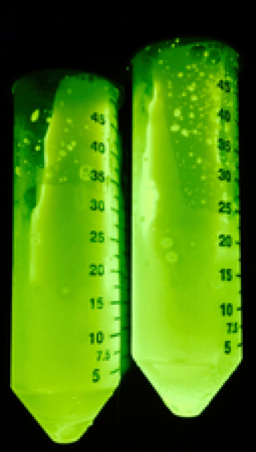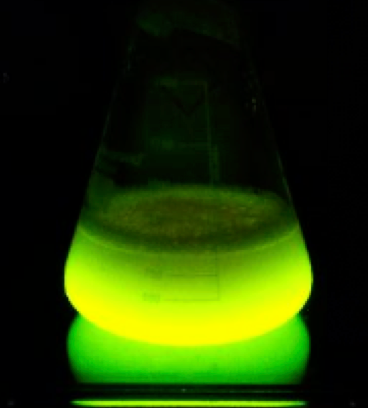|
|
| Line 14: |
Line 14: |
| | </html> | | </html> |
| | | | |
| | + | We moved our data from here to the main page! |
| | + | Please check : https://parts.igem.org/Part:BBa_I746909 |
| | | | |
| − | [[File:T--Gunma--AbsSTANDARD.JPG.png|600px|center|]]
| + | Gunma |
| − | Fig.1 This is our Abs600 Standard Curve measured by PerkinElmer,Multipmode Plate Reader.
| + | |
| − | | + | |
| − | [[File:T--Gunma--OurAbs600 Standard Curve.png|600px|center|]]
| + | |
| − | | + | |
| − | Fig.2 This is our Fluorescein Standard Curve measured by PerkinElmer,Multipmode Plate Reader(Exc485 nm,Ems530 nm).
| + | |
| − | | + | |
| − | [[File:T--Gunma--Our Rawdata.png|600px|center|alt text]]
| + | |
| − | Fig.2 This figure shows the fluorescence is highly proportional to Abs600,the concentration of microorganisms. This means the GFP fluorescence is to be precisely expressed by the microorganisms. One colony of BE21(DE3)pSB1C3 BBa I746909 each from 2 plates were picked and cultured in 5 mL LB medium with 34 μL/mL Cam for 6.25 hours in falcon tubes,37℃. We conducted 2 biological and 4 technical replicates. Then these are diluted to be OD600 = 0.1.before added 500 μM IPTG.Abs600 and fluorescence of GFP were measured.All measurements went on under controlled temperature (25 ℃).
| + | |
| − | | + | |
| − | [[File:T--Gunma--GFP plate UV.JPG|600px|center|alt text]]
| + | |
| − | Fig.3 We also checked whether the colonies on plates are expressing GFP that derives from pSB1C3 BBa I746909 by directly putting 100 μM and 300 μM IPTG onto the colonies in hemisphere by pipettes.We note that this also means we could check the appropriate concentration for this time, for the teams who read this later.100 μM worked enough, but 300 μM seemed to have induced GFP more strongly.We recommend you 300 μM as a better choice.
| + | |
| − | | + | |
| − | [[File:T--Gunma--GFP plates on.JPG|600px|center|alt text]]
| + | |
| − | | + | |
| − | Fig.4 The plates were also observed under visible light.We spotted a strong light toward the plates for 10 sec in advance to emphasize the difference between them.
| + | |
| − | | + | |
| − | [[File:T--Gunma--GFP tubes.JPG|600px|center|alt text]]
| + | |
| − | Fig.5 The BL21(DE3) in LB medium were also observed under visible light too. They were easily distinguished in room.
| + | |
| − | | + | |
| − | | + | |
| | | | |
| | <html> | | <html> |
Revision as of 01:27, 22 October 2019
This experience page is provided so that any user may enter their experience using this part.
Please enter
how you used this part and how it worked out.
Applications of BBa_I746909
2019 iGEM team Gunma Japan
2019 iGEM team Gunma Japanvalidated this part in BL21(DE3).
We moved our data from here to the main page!
Please check : https://parts.igem.org/Part:BBa_I746909
Gunma
2018 iGEM team Linkoping Sweden
2018 iGEM team Linkoping Sweden validated this part.
The IPTG induction of BBa_I746909 was validated by expressing the protein in E. coli (BL21). Fluorescence was measured over 16 hours after IPTG induction and the bacteria was incubated at 37°C. Excitation was measured at 488 nm and emission at 510 nm. The optical density was measured at 600 nm. Different induction concentration of IPTG was used to stimulate the expression. Experiments were conducted in an infinite M1000 PRO plate reader. Graphs show the mean values of fluorescents per bacteria of 6 replicates. The error bars for Figure 2. represent the 95 % confidence interval. Results seem to indicate that 10 mM IPTG will give the most effective induction response and that the IPTG promoter is very sensitive. We make this statement from the fact that our smallest induction concentration (0,025mM) induced almost the same amount of fluorescence as our next strongest induction concentration (1mM).
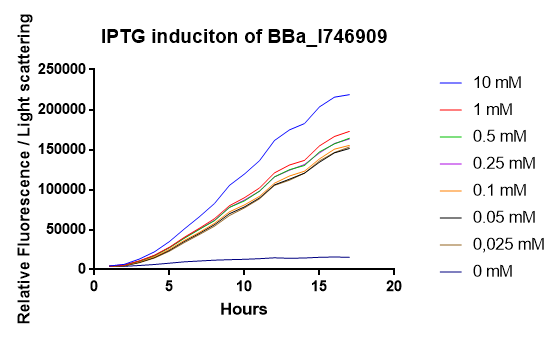
Figure 1: The figure shows IPTG stimulation of the biobrick BBa_I746909 over 16 hours, the mesurments was carried out in a 96 well M1000 Pro plate reader at 37°C. Fluorescence was exited at 488 nm and emission was measured at 510 nm . Light scattering were excited at 600 nm.
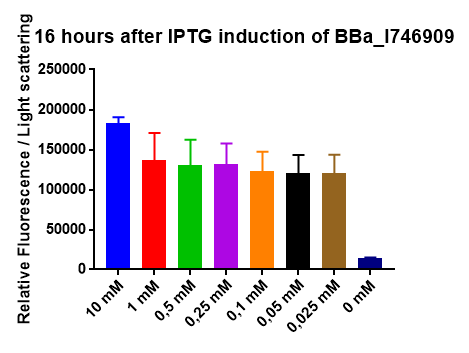
Figure 2: The figure shows the end results after a 16 hour IPTG induction of BBa_I746909 at 37°C. The induction was carried out in a M1000 Pro plate reader. Fluorescence was excited at 488 nm and emission was measured at 510 nm . Light scattering was excited at 600 nm. The error bars represent a 95% confidence interval.
[http://2014.igem.org/Team:Imperial iGEM Team Imperial
[http://2014.igem.org/Team:Aachen iGEM Team Aachen
The iGEM Team Aachen used the biobrick I746909 to test their [http://2014.igem.org/Team:Aachen/Project/2D_Biosensor sensor chip technology].
The biorbick I746909 was also used to test the measurement device [http://2014.igem.org/Team:Aachen/Project/Measurement_Device WatsOn].
2015 iGEM team Bielefeld-CeBiTec
2015 iGEM team Bielefeld-CeBiTec used this part and improved it by addition of a designed, translation enhancing 5'-untranslated region (5'-UTR; BBa_K1758100). You can find further information at BBa_K1758102).
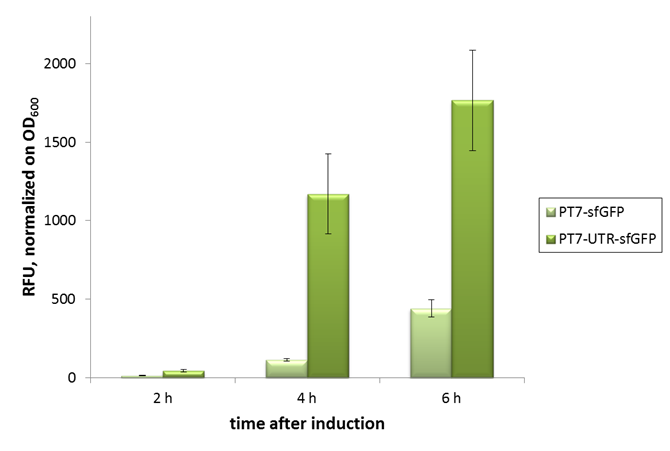
In vivo characterization of sfGFP with and without our designed, translation enhancing 5'-untranslated region (5'-UTR; BBa_K1758100). Relative fluorescence units were normalized on OD600. Error bars represent standard deviation of triplicates. PT7-sfGFP: BBa_I746909 (this part); PT7-UTR-sfGFP: BBa_K1758102
As can be seen in the picture, the difference was observable with the naked eye as well.
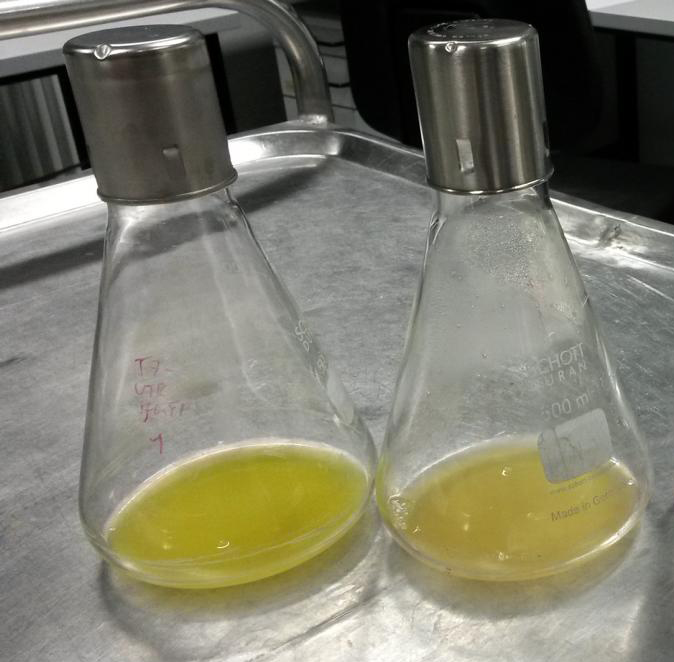
Comparision of cultures expressing sfGFP with the optimized UTR and without. Left: BBa_K1758102, right: BBa_I746909 (this part)
[http://2014.igem.org/Team:Imperial iGEM Team Imperial
[http://2014.igem.org/Team:Aachen iGEM Team Aachen
The iGEM Team Aachen used the biobrick I746909 to test their [http://2014.igem.org/Team:Aachen/Project/2D_Biosensor sensor chip technology].
The biorbick I746909 was also used to test the measurement device [http://2014.igem.org/Team:Aachen/Project/Measurement_Device WatsOn].
User Reviews
UNIQ207a0e8bed3412da-partinfo-00000007-QINU
UNIQ207a0e8bed3412da-partinfo-00000008-QINU








